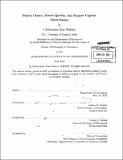School choice, school quality, and human capital : three essays
Author(s)
Walters, Christopher R
DownloadFull printable version (11.14Mb)
Other Contributors
Massachusetts Institute of Technology. Department of Economics.
Advisor
Joshua D. Angrist and Parag A. Pathak.
Terms of use
Metadata
Show full item recordAbstract
This dissertation consists of three essays covering topics in the economics of education. Two common threads connect these essays: first, a focus on the inputs and practices driving variation in effectiveness across educational programs; and second, an interest in the relationships between students' preferences, characteristics, and returns to human capital investment. In the first chapter, I develop and estimate a structural model of school choice that links students' decisions to apply to and attend charter schools in Boston, Massachusetts to their potential achievement test scores in charter schools and public schools. This chapter is motivated by a growing literature that uses randomized entrance lotteries to show that urban charter schools, including those in Boston, substantially increase test scores and close racial achievement gaps among their applicants. A key policy question is whether charter expansion is likely to produce similar effects on a larger scale. To address this question, I use the structural model to predict the effects of charter expansion for the citywide achievement distribution in Boston. Estimates of the model suggest that charter applicants are negatively selected on achievement gains: low-income students and students with low prior achievement gain the most from charter attendance, but are unlikely to apply to charter schools. This form of selection implies that lottery-based estimates understate gains for broader groups of students, and that charter schools will produce substantial gains for marginal applicants drawn in by expansion. Simulations suggest that realistic expansions are likely to reduce the gap in math scores between Boston and the rest of Massachusetts by up to 8 percent, and reduce racial achievement gaps by roughly 5 percent. Nevertheless, the estimates also imply that perceived application costs are high and that most students prefer traditional public schools to charter schools, so large expansions may leave many charter seats empty. These results suggest that in the absence of significant behavioral or institutional changes, the potential gains from charter expansion may be limited as much by demand as by supply. The second chapter, written jointly with Joshua Angrist and Parag Pathak, seeks to explain differences in effectiveness across charter schools. Using a large sample of lotteried applicants to charter schools throughout Massachusetts, we show that urban charter schools boost student achievement, while charter schools in other settings do not. We then explore student-level and school-level explanations for this difference. In an econometric framework that isolates sources of charter effect heterogeneity, we show that urban charter schools boost achievement well beyond that of urban public school students, while non-urban charters reduce achievement from a higher baseline. Student demographics explain some of these gains since urban charters are most effective for non-whites and low-baseline achievers. At the same time, non-urban charter schools are uniformly ineffective. Our estimates also reveal important school-level heterogeneity within the urban charter sample. A non-lottery analysis suggests that urban charters with binding, well-documented admissions lotteries generate larger score gains than under-subscribed urban charter schools with poor lottery records. Using a detailed survey of school practices and characteristics, we link charter impacts to inputs such as instructional time, classroom techniques and school philosophy. The relative effectiveness of urban lottery-sample charters is accounted for by these schools' embrace of the No Excuses approach to urban education, a package of policies that includes strict discipline, increased instructional time, selective teacher-hiring, and a focus on traditional skills. In the third chapter, I use data from the Head Start Impact Study (HSIS), a nationwide randomized trial of the Head Start program, to study the relationship between site-level treatment effects and educational inputs within Head Start. Studies of small-scale, intensive early-childhood programs, including the High/Scope Perry Preschool Project, show that such programs can have transformative effects on human capital and economic outcomes. Evidence for larger-scale programs like Head Start is more mixed. I use the HSIS data to ask whether Head Start centers using practices more similar to successful model programs produce larger short-run effects on cognitive and non-cognitive skills. My results show that while there is significant variation in effectiveness across Head Start centers, centers that are more similar to the Perry Preschool Project on observed dimensions are not more effective. Specifically, Head Start centers using the High/Scope curriculum, the centerpiece of the Perry experiment, do not produce larger gains relative to other centers. Other inputs often cited as essential to the success of the Perry Project, including teacher education, teacher certification, teacher/student ratios, instructional time, and frequency of home visiting, are also unrelated to effectiveness in Head Start. These results suggest that replicating the success of small-scale programs may be difficult, as the effectiveness of such programs may be due to idiosyncratic, unmeasured inputs. JEL Classification: 121, C51, J24
Description
Thesis (Ph. D.)--Massachusetts Institute of Technology, Dept. of Economics, 2013. Cataloged from PDF version of thesis. Includes bibliographical references (p. 173-180).
Date issued
2013Department
Massachusetts Institute of Technology. Department of EconomicsPublisher
Massachusetts Institute of Technology
Keywords
Economics.